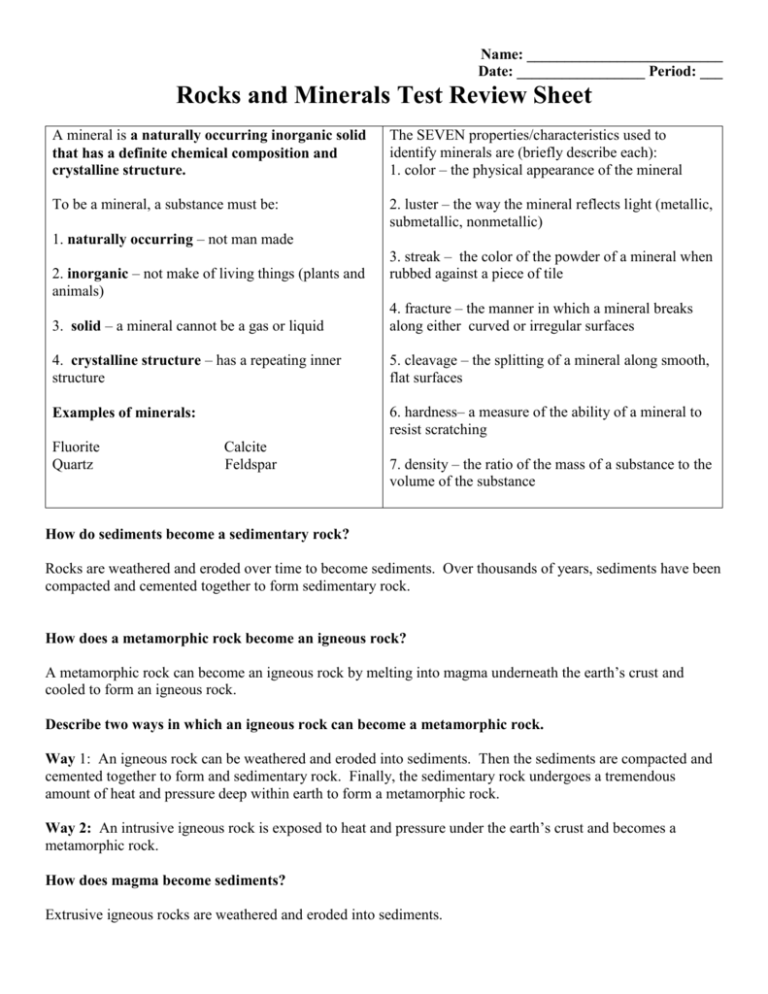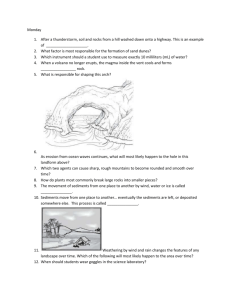Rocks and Minerals Test Review Sheet Answer KEy
advertisement

Name: __________________________ Date: _________________ Period: ___ Rocks and Minerals Test Review Sheet A mineral is a naturally occurring inorganic solid that has a definite chemical composition and crystalline structure. The SEVEN properties/characteristics used to identify minerals are (briefly describe each): 1. color – the physical appearance of the mineral To be a mineral, a substance must be: 2. luster – the way the mineral reflects light (metallic, submetallic, nonmetallic) 1. naturally occurring – not man made 2. inorganic – not make of living things (plants and animals) 3. streak – the color of the powder of a mineral when rubbed against a piece of tile 3. solid – a mineral cannot be a gas or liquid 4. fracture – the manner in which a mineral breaks along either curved or irregular surfaces 4. crystalline structure – has a repeating inner structure 5. cleavage – the splitting of a mineral along smooth, flat surfaces Examples of minerals: 6. hardness– a measure of the ability of a mineral to resist scratching Fluorite Quartz Calcite Feldspar 7. density – the ratio of the mass of a substance to the volume of the substance How do sediments become a sedimentary rock? Rocks are weathered and eroded over time to become sediments. Over thousands of years, sediments have been compacted and cemented together to form sedimentary rock. How does a metamorphic rock become an igneous rock? A metamorphic rock can become an igneous rock by melting into magma underneath the earth’s crust and cooled to form an igneous rock. Describe two ways in which an igneous rock can become a metamorphic rock. Way 1: An igneous rock can be weathered and eroded into sediments. Then the sediments are compacted and cemented together to form and sedimentary rock. Finally, the sedimentary rock undergoes a tremendous amount of heat and pressure deep within earth to form a metamorphic rock. Way 2: An intrusive igneous rock is exposed to heat and pressure under the earth’s crust and becomes a metamorphic rock. How does magma become sediments? Extrusive igneous rocks are weathered and eroded into sediments. What happens when an igneous rock is exposed to heat and pressure? An igneous rock exposed to heat and pressure becomes an metamorphic rock. Extra: The process of weathering and erosion creates what? Sediments How does an igneous rock become a sedimentary rock? An extrusive igneous rock is weathered and eroded into sediments. The sediments are compacted and cemented together to form a sedimentary rock. When a rock is exposed to heat and pressure, what type of rock is formed? Metamorphic Key Vocabulary 1. Mineral - A naturally occurring, inorganic solid that has definite chemical composition and crystalline structure 2. Element - A substance that cannot be broken down or separated into simpler substances by chemical means 3. Compound - A substance made up of two or more atoms of different elements that are chemically combined 4. Crystal - A solid whose atoms, ions, or molecules are arranged in a definite pattern 5. Silicate- A mineral that contains a combination of silicon, oxygen, and one or more metals 6. Non-silicate - A mineral that does not contain compounds of silicon and oxygen 7. Luster - The way in which a mineral reflects light 8. Streak - The color of the powder of a mineral 9. Cleavage - The splitting of a mineral along smooth, flat lines 10. Fracture - The manner in which a mineral breaks along either curved or irregular surfaces 11. Hardness - A measure of the ability of a mineral to resist scratching 12. Density - The ratio of the mass of a substance to the volume of the substance 13. Rock Cycle - The series of processes in which a rock forms, changes from one type of rock to another, is destroyed, and forms gain by geological processes 14. Rock - A naturally occurring solid mixture of one or more minerals or organic matter 15. Erosion - The process by which wind, water, ice or gravity transports soil and sediment from one location to another 16. Composition - The chemical make-up of a rock; describes either the minerals or other materials in the rock 17. Compaction - The consolidation of sediments resulting from the weight of the material above pushing down 18. Cementation - The binding of loose sediments or fragments into one rock 19. Texture - The quality of a rock that is based on the sizes, shapes, and positions of the rock’s grains 20. Intrusive Igneous Rock - Rocks formed from the cooling and solidification of magna beneath the Earth’s surface 21. Extrusive Igneous Rock - Rocks that forms as the result of volcanic activity at or near the Earth’s surface 22. Strata - Layers of rock 23. Stratification - The process in which sedimentary rocks are arranged in layers 24. Clastic Rocks - Rocks made of fragments of rocks cemented together by minerals such as calcite or quartz 25. Chemical Rocks - Form from solutions of dissolved minerals and water 26. Organic Rocks - Rocks formed from the remains of once living plants or animals 27. Foliated Rocks - Describes the texture of metamorphic rock in which the mineral grains are arranged in planes or bands 28. Non-foliated Rocks - Describes the texture of metamorphic rock in which the mineral grains are not arranged in planes or bands Types of Rocks Igneous: Sedimentary: Metamorphic: Created from magma (below the surface) or lava (above the surface) Created through the process of weathering and erosion, compaction and cementation and (chemical). Created when exposed to extreme heat and pressure. Characterized by grain size. Characterized by grain size and texture. Intrusive: Extrusive: Clastic: Chemical: Organic: Foliated: Non-foliated: Where formed? Where formed? Inside earth At or near earth’s surface Formed through what 2 processes? Formed through the chemical process of crystallization. Formed from the remains of once living plants and animals. Foliated - the texture of metamorphic rock in which the mineral grains are aligned in planes or bands Non-foliated – the texture of the metamorphic rock in which the mineral grains are NOT arranged in planes or bands Examples: Halite Examples: corals Examples: Gneiss Phyllite Schist Examples: Marble Quartzit Speed of formation: Speed of formation: Slowly Quickly Grain Size: Grain Size: Large/coarse Small/fine Examples: Examples: Granite Gabbro Rhyolite Basalt Compaction and cementation Classified according to the size of the grains (coarse, medium, fine) Examples: Conglomerate Sandstone Siltstone Shale







